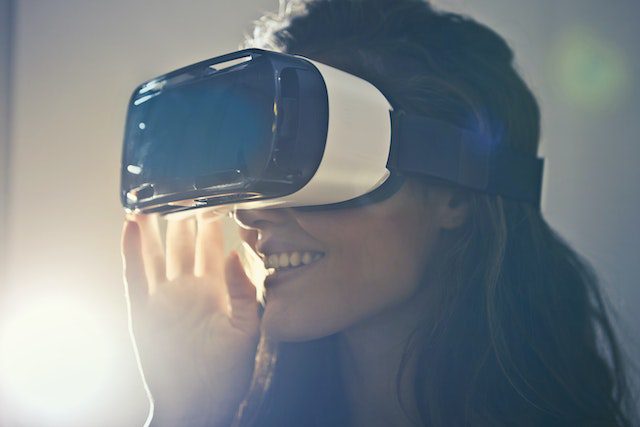Web AR, or Web-based Augmented Reality, refers to the integration of digital information with the physical world through a device’s camera. The technology offers a new way to interact with digital content and has become increasingly popular in recent years. In today’s digital age, Web AR has the potential to revolutionize the way we interact with the world around us. It can enhance our shopping experience, improve our education, and bring new levels of engagement to gaming and entertainment. There are several Web AR platforms and tools available, including 8th Wall, AR Studio by Facebook, ARCore by Google, and ARKit by Apple. These tools allow developers to create and distribute AR experiences easily and cost-effectively. The possibilities for Web AR are endless, and its importance in our digital age cannot be overstated.
Web AR, or Web-based Augmented Reality, refers to the integration of digital information with the physical world through a device’s camera. The technology offers a new way to interact with digital content and has become increasingly popular in recent years. In this article, we will explore various Web AR platforms and tools, their advantages, and use cases. We will also discuss the challenges in implementing Web AR and its potential future developments.
Web AR Platforms
-
8th Wall
8th Wall is a Web AR platform that allows developers to create AR experiences without the need for a native app. It supports a wide range of devices and can be easily integrated into existing websites. 8th Wall also provides a suite of tools for creating and publishing AR content, making it a popular choice for developers.
-
AR Studio by Facebook
AR Studio by Facebook is a tool that enables developers to create AR experiences for Facebook’s camera platform. It provides a range of tools and templates to help developers get started quickly and easily. AR Studio also supports the creation of face filters and world effects, making it a popular choice for AR content creators.
-
ARCore by Google
ARCore is a Web AR platform developed by Google. It provides a set of tools and APIs for building AR experiences that work across a range of devices. ARCore also provides support for ARKit and ARCore, making it a great choice for developers looking to reach a large audience.
-
Vuforia by PTC
Vuforia is a Web AR platform that provides tools for creating AR experiences across a range of devices. It supports image recognition, object recognition, and location-based AR, making it a versatile platform for developers. Vuforia also provides a suite of tools for creating and publishing AR content, making it a popular choice for AR content creators.
-
ARKit by Apple
ARKit is a Web AR platform developed by Apple. It provides a suite of tools and APIs for creating AR experiences that work on Apple devices. ARKit is widely used by developers and content creators, thanks to its high-quality AR experiences and support for advanced AR features.
Web AR Tools
1. Sketchfab
Sketchfab is a Web AR tool that allows developers to publish and share 3D models in AR. It provides a simple and easy-to-use platform for creating AR content and is widely used by 3D artists and designers.
2. A-Frame by Mozilla
A-Frame by Mozilla is a Web AR tool that provides a simple and accessible way to create AR experiences. It uses HTML and JavaScript to create AR experiences, making it a popular choice for developers looking for a low-code AR solution.
3. AR.js by Jerome Etienne
AR.js is a Web AR tool that provides a simple and easy-to-use solution for creating AR experiences. It uses JavaScript to create AR experiences and supports a wide range of devices, making it a popular choice for developers.
4. Babylon.js
Babylon.js is a Web AR tool that provides a suite of tools and APIs for creating AR experiences. It uses JavaScript to create AR experiences and supports a wide range of devices, making it a popular choice for developers.
5. XR Studio by Unity
XR Studio by Unity is a Web AR tool that provides a suite of tools and APIs for creating AR experiences. It uses the Unity game engine to create AR experiences and supports a wide range of devices, making it a popular choice for developers.
Advantages of Web AR
1. Accessibility
Web AR allows users to access AR experiences directly through their web browser, making it easier and more accessible than traditional native AR experiences. This eliminates the need for users to download and install an AR app, making AR experiences more accessible to a wider audience.
2. Cost-effectiveness
Web AR provides a cost-effective solution for businesses and organizations looking to create AR experiences. With the option to create AR experiences directly on websites, there is no need to invest in costly app development, reducing the overall cost of AR implementation.
3. Interactivity
Web AR offers an interactive and engaging experience for users. By combining digital content with the physical world, Web AR provides a new level of interaction and engagement with digital content.
4. Integration with existing web technologies
Web AR can be easily integrated with existing web technologies, such as websites, e-commerce platforms, and marketing tools, making it a versatile solution for businesses and organizations.
5. Measurable results and ROI
Web AR provides measurable results and a high return on investment for businesses and organizations. With the ability to track user engagement and conversion rates, businesses can easily measure the success of their AR campaigns.
Use Cases of Web AR
1. E-commerce and Retail
Web AR provides a new level of engagement and interaction for e-commerce and retail businesses. By allowing customers to experience products in AR, businesses can provide a more immersive shopping experience and increase customer satisfaction.
2. Education and Training
Web AR provides a new way to deliver education and training content to students. By combining digital content with the physical world, Web AR provides a more interactive and engaging learning experience for students.
3. Marketing and Advertising
Web AR provides a new platform for businesses and organizations to engage with their target audience. With the ability to create interactive AR experiences, businesses can increase brand awareness and engagement with their target audience.
4. Gaming and Entertainment
Web AR provides a new platform for gaming and entertainment experiences. With the ability to combine digital content with the physical world, Web AR provides a more immersive and engaging gaming experience.
5. Healthcare and Medicine
Web AR provides a new way for healthcare and medical professionals to deliver patient education and training. By combining digital content with the physical world, Web AR provides a more interactive and engaging learning experience for patients.
Challenges in Implementing Web AR
Compatibility with existing technology
Implementing Web AR can be challenging, as it requires compatibility with existing technology, such as websites and e-commerce platforms. This can be a complex and time-consuming process, especially for businesses and organizations with limited technical expertise.
User privacy and security
Web AR also raises concerns about user privacy and security, as the technology relies on the use of a device’s camera. Businesses and organizations need to ensure that they are using Web AR in a way that respects user privacy and protects sensitive information.
Technical skills required to create AR experiences
Creating AR experiences requires technical skills, such as programming and 3D modeling. This can be a barrier for businesses and organizations with limited technical expertise, making it difficult for them to implement Web AR.
Cost and complexity of development
Developing AR experiences can be expensive and complex, especially for businesses and organizations with limited resources. This can make it difficult for businesses to implement AR and realize the full benefits of the technology.
Limited AR hardware support
AR experiences require specialized hardware, such as AR-enabled devices and sensors. This can limit the reach of AR experiences, making it difficult for businesses to reach a wide audience.
Conclusion:
Web AR provides a new way for businesses and organizations to interact with digital content and engage with their target audience. With the availability of Web AR platforms and tools, businesses can create AR experiences directly on websites, reducing the cost and complexity of AR implementation. Web AR offers a high return on investment for businesses, with the ability to track user engagement and conversion rates.
However, implementing Web AR also presents challenges, such as compatibility with existing technology, user privacy and security concerns, the technical skills required to create AR experiences, the cost and complexity of development, and limited AR hardware support.
Despite these challenges, the potential for Web AR is vast, with use cases in industries such as e-commerce and retail, education and training, marketing and advertising, gaming and entertainment, and healthcare and medicine. As technology continues to evolve and the use of AR becomes more widespread, businesses and organizations can expect to see further advancements in the use of Web AR.



































